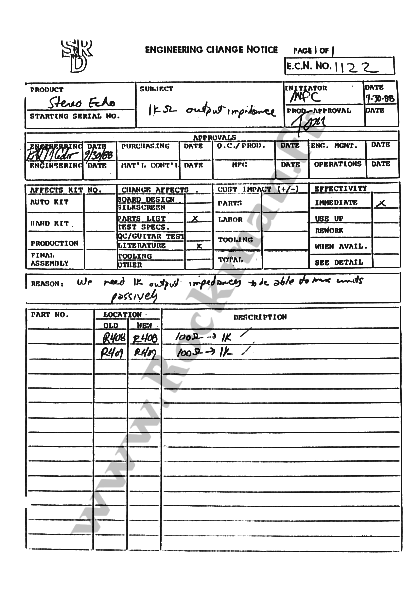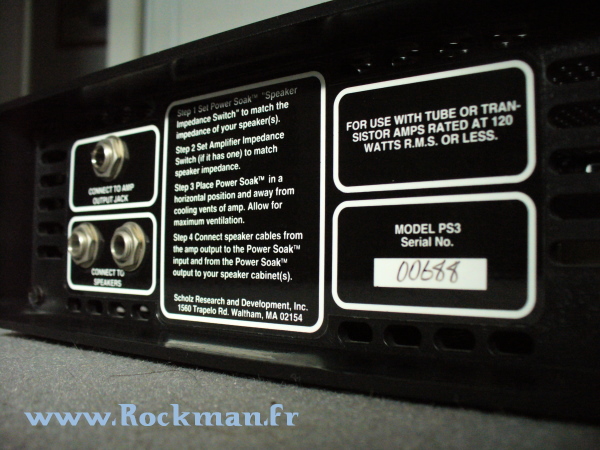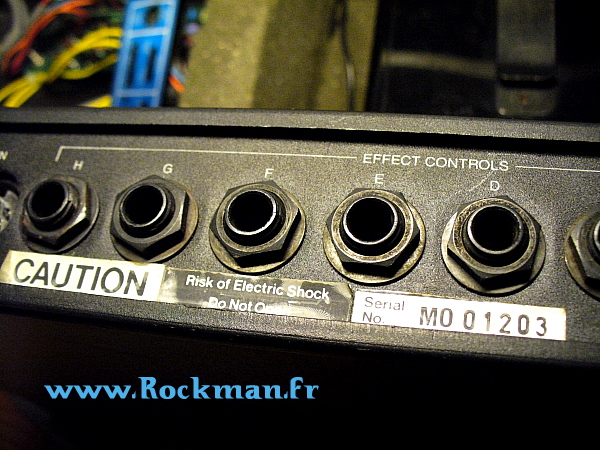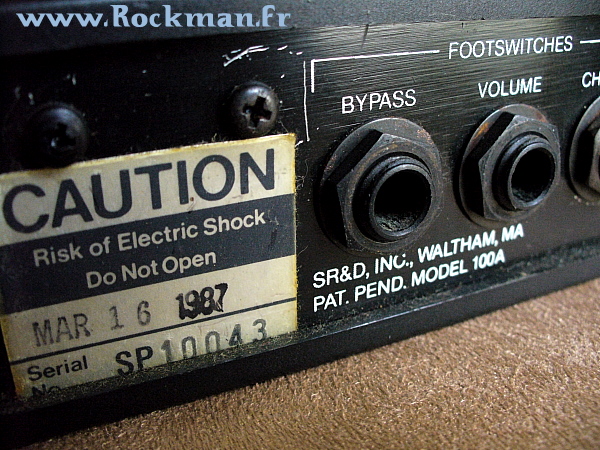Preliminary remark
You will find dates stamped on all the SR&D products, that some of you may use to date their gear. These Copyright indications cannot be used to estimate the age of the gear, cause they correspond to the copyright of the graphic design and have no link with the item itself.
The Copyright, symbolised by the circled C ©, is a legal protection of graphic works such as schematics, PCB layouts, or front-plate designs. The date is the year when the work was done. You will thus find ©1985 on all the Rockman Sustainors, though the 200 didn't exist before 1987.
Engineering revisions
The Rockman products were undergoing continuous improvements. In an industrial activity, every change in a circuit must be justified and validated, and a record is kept of all these changes. Of course, it is not recommended to create a new version every time you change one resistor or one cap: a revision usually groups several minor changes, but can also correspond to a real change in the circuit design.
At SR&D’s, some revisions corresponded to off-board wiring, without PCB modification, while others corresponded to major changes, with some layout modifications and a new PCB.
It is therefore impossible to estimate precisely how many versions were issued for each product: the PCB's revisions were clearly identified, but several modifications can exist for the same PCB version. You can also, for example, find a REV3 front PCB with a REV4 main board...
Three versions for the Power Soak, ten for the Rockman and X100 headphones amps, and probably more than ten for the Rockman Sustainor!
It is actually very difficult, when you buy a used Rockman item, to really know what you will get. The sellers on eBay don’t have the curiosity to check this REV# before placing their ad, and you’re lucky when you can get the basic details that allow dating an item.
The “problem” is that the best Rockman products are the youngest ones: they include all the improvements that SR&D has brought to the products from 1980 to 1994.
Let's review, product by product, the simple rules to apply when you want to know the age of a Rockman item.
|
 |
Power Soak
 |
There were three distinct Power Soaks:
- The Power Soak I, made from 1980 to 1981, has the jacks on the front board, and no tube/solid state switch
- The Power Soak II, the most common version, was introduced in 1982, and has this tube/solid-state switch.
- The Power Soak III, has no tube/solid-state switch, and has the three jacks on the rear panel. The re-issued Power Soak, in 1992, was the Power Soak III (PS-3).
The three models work great with any power tube (see the Samples for a comparison), and since the Power Soak is almost useless with a solid-state amp, the Tube/Solid-state switch is not critical.
The Model I and Model II have a serial number on the rear panel that indicates the year (81 or 82) followed by a serial number.
The Power Soak PS3, re-issued in 1992, has a hand-written serial number on the rear panel.
|
Headphones amps
 |
Unless you can open the unit and check the REV# on the PCB, the external aspect of the Rockman headphone amps won’t learn you much. You can yet have the critical and necessary information just by looking at the back panel.
- “Rockman”, or “Pat. Pending”: that’s an early model, 1982 for sure. It can be a REV01, REV02 or a REV03.
- A “Rockman II” is from 1983 (REV04 or REV05)
- A Rockman IIB (REV06 or REV07) is from 1983 or 1984.
The Rockman X100 was introduced in 1984, and there are three possible REV’s:
- The rare REV08 is stamped Rockman X100 on the rear panel, but the front panel is marked “Rockman”, like the Rockman I, II and IIB.
- The X100 REV09 has the Rockman X100 front panel, but has no side TRS mini-jack for an external power-supply. The earlier REV10’s don’t have it either.
- The X100 REV10 has the Rockman X100 front panel, and has a side mini-jack for the power-supply. The corresponding mention is printed on the rear panel (“For Use with the SR&D regulated power-supply only”).
|
The Soloist and the Bass Rockman are easier to date: when they have no side TRS mini-jack for the +/-6V wallwart, they were built between 1984 and 1986. If they have this mini-jack (like the X100 REV10 on the above picture), they were build in 1986 of later. As far as I know, there’s only one technical revision for the Soloist, and two for the Bass Rockman.
The rare Rockman Ultralight was derived from the Rockman IIB. It is always from 1983, and can be a REV06 or a REV07.
Rockmodules and XP Series
The Rockmodules and XP Series are easier to date: they have their manufacturing tag, that displays both the Serial Number and the Manufacturing Date (at least since 1987).
Due to the lack of space, the Midi Octopus has only a serial number (no manufacturing date).
The mention “Model 100” is useless and has no meaning: all the modules have this Model 100 print on the rear panel, with a few exceptions:
- The Sustainor 100A, stamped Model 100A
- The Sustainor 200, stamped “Model 200”
- The Smart Gate, with no indication (nor 100 nor 200)
- The extremely rare Dual Remote Loop, that has no indication at all on the rear panel
|
 |
Sustainor
 |
The Sustainor has a more complex story and it’s worth a special table for it. Rockman-Central holds count of more precise data about the Sustainor: the following table is only a summary showing the main steps. Consider it as an indication: only the original SR&D logs could tell us the truth!
The S/N's are rounded for an easier reading: it is usually necessary to check the reality on a case by case basis, especially for the Sustainor 100A and the Double-IC Sustainors.
The back panel will tell if it’s a Sustainor 100, 100A or 200, but a Double-IC can be confirmed only by opening the unit.
The first Rockmodules (Sustainor 100 and Chorus/Delay) produced in 1986 had no manufacturing date on their tag. As of Rockman-Central, the Sustainor #9208 was issued on Feb. 02 1987, and we can assume that the Sustainor #1 was issued on 1/1/1986. So, for example, the Sustainor #2783 was thus probably manufactured in April or May 1986.
The transitions between the models and revisions were not strict: some Double IC 200’s were issued before June 89, and some 100A’s were probably issued before March 87 (the oldest I know is #9985, March the 13th)
|
Serial Number | Manufacturing date | Type |
| From 0 to 9200 | Jan 1986 to Jan 1987? | Sustainor 100 w/o Manuf. Date |
| From 9200 to 10000 | Feb 1987? to March 1987? | Sustainor 100 with Manuf. Date |
| From 10000 to 13500 | March 1987? to Sep 1987 | Sustainor 100A |
| From 13500 to 19500 | Oct 1987 to June 1989 | Sustainor 200 |
| From 19500 to 21000 | June 1989 to May 1992 | Sustainor 200 Double IC |
|
